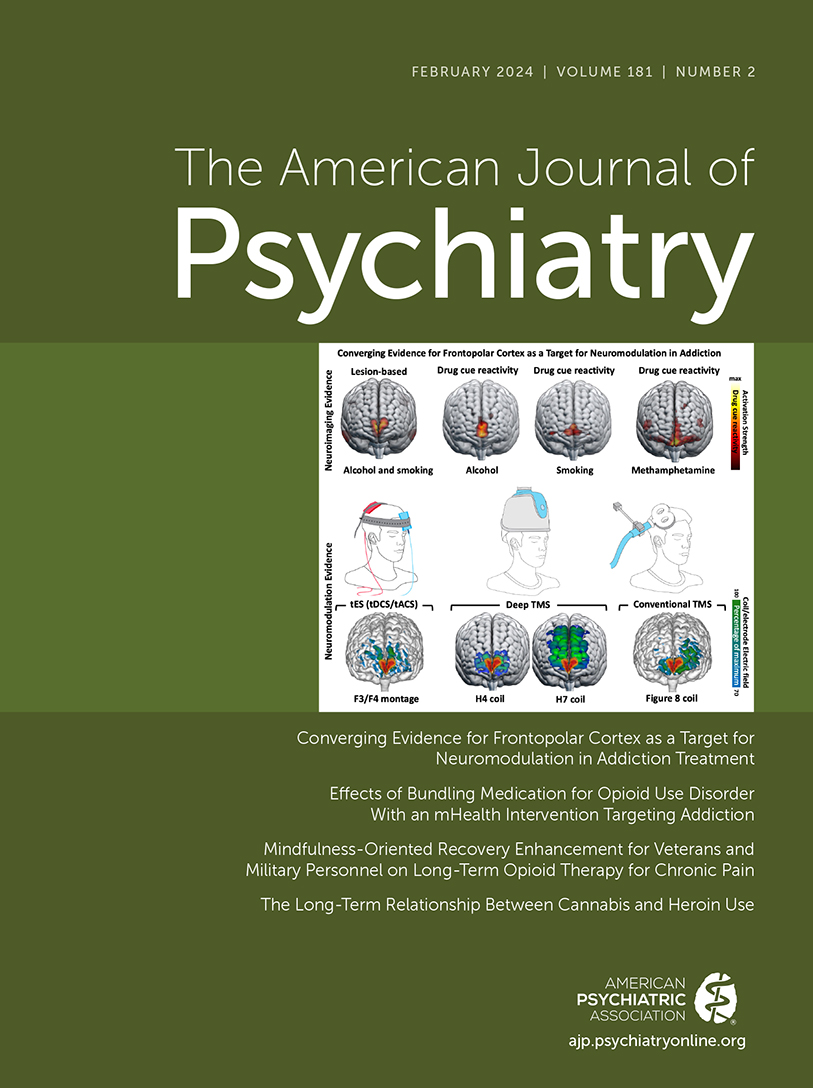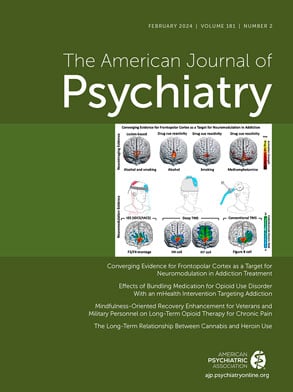Chronic pain and opioid misuse are threats to U.S. military personnel and veterans, who may develop problematic opioid use coincident with long-term opioid therapy for pain conditions incurred during military service. Many military personnel and veterans who suffer from persistent pain conditions are treated with long-term opioid therapy, which increases the risk of transitioning to opioid misuse (
1). Chronic pain is prevalent among military personnel, with 30% having a chronic pain diagnosis (
2) and 44% reporting chronic pain following deployment (
3). Among active-duty soldiers returning from deployment, 35% received an opioid prescription (
4). Opioids were prescribed to 33% of veterans in 2012 (
5). Although studies from the Veterans Health Administration have documented decreases in the prevalence rates of long-term opioid therapy (
6), 25%–29% of veterans receiving such therapy for pain subsequently exhibit aberrant drug-related behaviors, such as unauthorized dose escalation and opioid self-medication of negative affective states, that mark the transition from medically appropriate opioid use to misuse (
7). Opioid misuse among patients receiving long-term opioid therapy for chronic pain may arise from the neuroplastic effects of prolonged opioid use on brain reward circuits, which can increase opioid cue reactivity and craving and simultaneously reduce sensitivity to pleasure derived from natural rewards (
8). Such reward dysregulation is thought, in turn, to result in higher levels of anhedonia and dysphoria that compel opioid dose escalation as a means of maintaining hedonic equilibrium (
9). In part because of the complexities presented by these intersecting pathogenic mechanisms, there is a dearth of efficacious interventions for veterans and military personnel with chronic pain treated with long-term opioid therapy.
To meet this need, we conducted a randomized clinical trial of Mindfulness-Oriented Recovery Enhancement (MORE) in a sample of veterans and military personnel receiving long-term opioid therapy for chronic pain. MORE unites complementary aspects of mindfulness training, cognitive-behavioral therapy, and principles from positive psychology to restructure dysregulated reward processes underpinning the cycle of behavioral escalation that links chronic pain to opioid misuse. In a recent meta-analysis, MORE was shown to produce statistically significant effects on addictive behavior, chronic pain, and psychiatric symptoms among civilians (
10). Yet, its efficacy among veterans and military personnel remains unknown. Here we conducted an efficacy test of MORE versus supportive psychotherapy for outcomes including chronic pain, aberrant drug-related behaviors, and opioid use, as well as psychiatric symptoms, pain catastrophizing, reward-related processes, opioid craving, and opioid cue reactivity.
Results
Participant Characteristics
Of the 331 patients assessed for eligibility, we enrolled 230 (
Figure 1). Of this sample, 83% were male and 91% were veterans, with the remainder being active-duty military personnel. Participants had a mean age of 57.5 years (SD=11.7), mean BPI pain severity score of 5.6 (SD=1.5), mean COMM score of 13.4 (SD=7.8), and a mean morphine equivalent daily opioid dose of 105.3 mg (SD=204.6; interquartile range, 12.0–90.0 mg). More than half of the participants (55%) reported having oxycodone or hydrocodone prescriptions. Participants reported having pain for a mean duration of 19.3 years (SD=12.6), and pain was most commonly reported to be in the lower back (81%). Major depressive disorder was prevalent in the sample (60%), but a substantial proportion of participants also met clinical criteria for opioid use disorder (34%) or posttraumatic stress disorder (PTSD) (19%), based on the Mini-International Neuropsychiatric Interview at baseline, with no between-group differences. Participants in the MORE and supportive psychotherapy conditions attended a mean of 5.5 and 5.7 sessions, respectively. Data for one or more outcome variables from the 8-month follow-up were available for 81% of participants. Demographic and baseline clinical characteristics were similar between the two groups (
Table 1).
Outcomes
Treatment effects of MORE and supportive psychotherapy on primary outcomes, secondary outcomes, and process variables are presented in
Table 2. For pain and opioid use outcomes through the 8-month follow-up, the omnibus multivariate likelihood ratio test was significant (χ
2=13.09, df=4, p=0.011), indicating the superiority of MORE over supportive psychotherapy. Compared with supportive psychotherapy, MORE produced significantly greater reductions in pain interference (B=0.47, 95% CI=0.10–0.84, p=0.011) and pain severity (B=0.27, 95% CI=0.00–0.54, p=0.048). Although aberrant drug-related behaviors decreased significantly in both groups over time (B=0.50, 95% CI=0.08–0.92, p=0.019) with no significant between-group differences (p=0.43), MORE reduced aberrant drug-related behaviors to a significantly greater extent than supportive psychotherapy in the in-person cohorts (B=0.48, 95% CI=0.01–0.96, p=0.047). No between-group differences were observed in the clinical interview of opioid misuse or in urine drug screen measures, except at an exploratory 12-month follow-up point extracted from EMRs; at this time point, among the patients who completed random urine drug screens (N=38), a smaller percentage of those in the MORE condition (13.3%, N=2) had a positive urine screen compared with those in the supportive psychotherapy condition (43.5%, N=13) (likelihood ratio, χ
2=4.13, df=1, p=0.042). With regard to opioid use, MORE reduced daily opioid dose (square root transformed values) to a significantly greater extent than supportive psychotherapy (B=0.65, 95% CI=0.07–1.23, p=0.029); there was a 20.7% reduction in the mean opioid dose (18.88 mg, SD=8.40 mg) in the MORE condition compared with a 3.9% reduction (3.19 mg, SD=4.38 mg) in the supportive psychotherapy condition. Sensitivity analyses controlling for auxiliary variables associated with missingness also found that MORE outperformed supportive psychotherapy in reducing pain interference (p=0.010), pain severity (p=0.025), and opioid dose (p=0.025).
For secondary outcomes through the 8-month follow-up, the omnibus multivariate likelihood ratio test was highly significant (χ2=32.51, df=5, p<0.00001). No significant between-group differences were observed for emotional distress (p=0.102) or PTSD symptoms (p=0.175); participants in both treatment conditions improved over time. However, MORE reduced anhedonia (B=2.27, 95% CI=1.11–3.42, p<0.001) and pain catastrophizing (B=2.54, 95% CI=1.19–3.98, p<0.001) and improved positive affect (B=1.50, 95% CI=0.15–2.85, p=0.029) to a significantly greater extent than supportive psychotherapy.
For the process variables, the omnibus multivariate likelihood ratio test was highly significant (χ2=32.79, df=5, p<0.00001). MORE produced greater increases than supportive psychotherapy for all process variables, including mindful reinterpretation of pain sensations (p<0.001), nonreactivity to distressing thoughts and emotions (p=0.030), cognitive reappraisal (p=0.011), savoring (p=0.036), and attention to positive information (p=0.001).
Regarding ecological momentary assessment of opioid craving, craving ratings decreased over the course of treatment by 0.67 points more in the MORE condition than in the supportive psychotherapy condition (95% CI=0.001–0.007, p=0.019). Finally, participants assigned to MORE exhibited significantly greater decreases in the 200-ms opioid attentional bias measure than participants in supportive psychotherapy (B=29.89 ms; 95% CI=3.77–56.01; p=0.025). No significant group differences were observed with the 2,000-ms attentional bias measure.
Discussion
In a sample of past and present U.S. military personnel on long-term opioid therapy, treatment with MORE was associated with significantly greater reductions in chronic pain symptoms and opioid use than supportive psychotherapy. The pain-relieving effects of MORE were coupled with reductions in pain catastrophizing and an increased capacity to mindfully reinterpret pain as an innocuous sensory signal that does not necessarily signify harm. Although aberrant drug-related behaviors decreased substantially over time for both treatment groups, significantly greater reductions in aberrant drug-related behaviors were observed with the in-person MORE intervention when compared with supportive psychotherapy. In a similar manner, both MORE and supportive psychotherapy were associated with reduced emotional distress and PTSD symptoms; however, MORE showed clear superiority for improving reward-related processes, including positive affect, anhedonia, savoring, and attention to positive information. Finally, MORE was associated with reduced opioid craving measured in daily life and decreased opioid cue reactivity measured in the laboratory with a dot-probe task.
These findings converge with our previous research with civilians that demonstrated the efficacy of MORE for reducing pain and opioid use (
14). Here, MORE facilitated opioid dose reduction while preserving adequate pain control and preventing disturbances in mood, suggesting the utility of MORE as an adjunctive therapy for safe opioid tapering among veterans and military personnel. MORE produced the largest opioid dose reductions among patients with lower back pain or arthritis. The observed dose reductions are especially remarkable given that participants were not given specific tapering instructions as part of the study. Future trials might combine MORE with a patient-centered opioid-tapering approach to produce even greater reductions in opioid dosing.
The effects of MORE on opioid misuse in this study were less robust than those reported in our previous trial, where we found that MORE reduced opioid misuse by 45%, more than doubling the effect of supportive psychotherapy (
14). Delivering MORE via teletherapy may have attenuated its effect size. Alternatively, supportive psychotherapy may have been more effective during the COVID-19 pandemic, when social isolation drove despair that fueled opioid misuse and an unprecedented number of overdose deaths. Or military populations may be more difficult to treat than civilians as a result of chronic exposure to extreme stress. Nonetheless, urine screen data from EMRs suggested that MORE may produce long-term reductions in illicit drug use and nonprescribed opioid use; additional studies with longer-term follow-ups are needed to replicate this effect.
Notably, MORE decreased attentional bias for opioid-related cues presented for 200 ms but not for cues presented for 2,000 ms, suggesting that the effects of MORE were most evident during the initial automatic attentional orienting to the cue and not during the stage of attentional disengagement (
39). Thus, instead of an effortful shifting of attention away from drug cues (e.g., avoidance), MORE might decrease drug cue reactivity in a bottom-up fashion by dampening the incentive salience of the drug. Congruent with this result, previous studies indicated that MORE reduces electrocortical indices of opioid cue reactivity (
40). According to our restructuring reward hypothesis (
9), MORE restructures bottom-up reward processing from the valuation of drug-related reward back to a valuation of natural reward; this shift occurs by strengthening cognitive control over reward processing through techniques that devalue the drug (e.g., mindfulness of craving and reappraisal of negative consequences of drug use) and increase the competing value of nondrug natural rewards (e.g., savoring). In that regard, previous studies have shown that MORE increases EEG markers of cognitive control (
41) and natural reward responsiveness (
9,
40). Concomitantly, in the present study, MORE significantly boosted positive affect, savoring, and attention to positive information while reducing anhedonia, suggesting that MORE improves responsiveness to natural rewards and providing additional support for the restructuring reward hypothesis.
The primary limitation of the trial was the rate of loss to follow-up, which was exacerbated by the COVID-19 pandemic. Nonetheless, our trial retention rate was superior to that of other psychotherapy trials of opioid users (mean discontinuation rate of 42%) (
37) and trials of medications for opioid use disorder of shorter durations (e.g., 24 weeks) (
42). Because dropout rates did not differ between treatment arms, missing data were unlikely to bias outcome analyses toward one of the groups. Sensitivity analyses controlling for auxiliary covariates associated with missingness showed the superiority of MORE over supportive psychotherapy. The study was also limited because it was not possible to blind participants to treatment assignment; nonetheless, participants were informed that the study was designed to compare two active treatments, and the experimental conditions were not identified. Because the sample was predominantly White and male, the findings may not generalize to non-White racial groups. Finally, because we had originally intended to test the in-person MORE intervention and switched to remote delivery only after the onset of the COVID-19 pandemic, we did not have adequate statistical power to test remote versus in-person formats as a treatment moderator. Future fully powered noninferiority trials should assess whether delivering MORE remotely produces results comparable to the in-person format.
In summary, MORE demonstrated efficacy in reducing chronic pain and opioid use among veterans and military personnel being treated with long-term opioid therapy. Implementation and dissemination research should assess how to best deliver MORE to individuals across the Veterans Health Administration and the Department of Defense.


